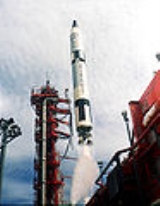
Titan II GLV
Encyclopedia
The Titan II GLV or Gemini-Titan was an American
expendable launch system
derived from the Titan II missile, which was used to launch twelve Gemini
missions for NASA
between 1964 and 1966. Two unmanned launches followed by ten manned ones were conducted from Launch Complex 19
at the Cape Canaveral Air Force Station
, starting with Gemini 1
on 8 April 1964.
The man-rated
Titan II was a liquid-propelled rocket, and consisted of two stages. The first stage was powered by two LR87 engines, whilst the second stage was propelled by an LR91 engine.
The rockets were purpose-built for the Gemini launches, and featured some modifications compared to the Titan missiles. A malfunction detection system was installed to inform the crew of the rocket's status, and improve response in an emergency. Redundant systems, including a backup flight control system, were fitted to reduce the chances of launch failures. The second stage was modified to accommodate the Gemini spacecraft, and unnecessary vernier engines
and retro-rockets were removed. An inertial guidance system replaced the radio control system used on the missiles, and modifications were made to the tracking, electrical and hydraulics systems. Modifications were overseen by the Air Force Systems Command
.
United States
The United States of America is a federal constitutional republic comprising fifty states and a federal district...
expendable launch system
Expendable launch system
An expendable launch system is a launch system that uses an expendable launch vehicle to carry a payload into space. The vehicles used in expendable launch systems are designed to be used only once , and their components are not recovered for re-use after launch...
derived from the Titan II missile, which was used to launch twelve Gemini
Project Gemini
Project Gemini was the second human spaceflight program of NASA, the civilian space agency of the United States government. Project Gemini was conducted between projects Mercury and Apollo, with ten manned flights occurring in 1965 and 1966....
missions for NASA
NASA
The National Aeronautics and Space Administration is the agency of the United States government that is responsible for the nation's civilian space program and for aeronautics and aerospace research...
between 1964 and 1966. Two unmanned launches followed by ten manned ones were conducted from Launch Complex 19
Cape Canaveral Air Force Station Launch Complex 19
Launch Complex 19 is a deactivated launch site on Cape Canaveral Air Force Station, Florida used by NASA to launch all of the Gemini manned spaceflights. It was also used by unmanned Titan I and Titan II launch vehicles....
at the Cape Canaveral Air Force Station
Cape Canaveral Air Force Station
Cape Canaveral Air Force Station is an installation of the United States Air Force Space Command's 45th Space Wing, headquartered at nearby Patrick Air Force Base. Located on Cape Canaveral in the state of Florida, CCAFS is the primary launch head of America's Eastern Range with four launch pads...
, starting with Gemini 1
Gemini 1
Gemini 1 was the first unmanned test flight of the Gemini spacecraft in NASA's Gemini program. Its main objectives were to test the structural integrity of the new spacecraft and modified Titan II ICBM...
on 8 April 1964.
The man-rated
Human-rating certification
Human-rated or man-rated are terms used to describe the certification of a spacecraft, launch vehicleor airplaneas worthy of transporting humans. NASA and the U.S. GAO now uses "Human-rating" when describing requirements for these systems...
Titan II was a liquid-propelled rocket, and consisted of two stages. The first stage was powered by two LR87 engines, whilst the second stage was propelled by an LR91 engine.
The rockets were purpose-built for the Gemini launches, and featured some modifications compared to the Titan missiles. A malfunction detection system was installed to inform the crew of the rocket's status, and improve response in an emergency. Redundant systems, including a backup flight control system, were fitted to reduce the chances of launch failures. The second stage was modified to accommodate the Gemini spacecraft, and unnecessary vernier engines
Vernier thruster
A vernier thruster is a thruster used on a spacecraft for attitude control. It is a smaller thrust motor than main attitude control motors and is used for fine adjustments to the attitude or velocity of a spacecraft...
and retro-rockets were removed. An inertial guidance system replaced the radio control system used on the missiles, and modifications were made to the tracking, electrical and hydraulics systems. Modifications were overseen by the Air Force Systems Command
Air Force Systems Command
Air Force Systems Command is a former United States Air Force command. Its headquarters was located at Andrews Air Force Base, Maryland...
.
See also
- SM-65D AtlasSM-65D AtlasThe SM-65D Atlas, or Atlas D, was the first operational version of the U.S. Atlas missile. It first flew on April 14, 1959. Atlas D missiles were also used for orbital launches, both with upper stages and on their own as a stage-and-a-half vehicle....
- Soyuz (rocket)Soyuz (rocket)The Soyuz was a Soviet expendable carrier rocket designed by OKB-1 and manufactured by State Aviation Plant No. 1 in Samara, Russia. It was used to launch Soyuz spacecraft as part of the Soyuz programme, initially on unmanned test flights, followed by the first 19 manned launches of the...
- Voskhod (rocket)

